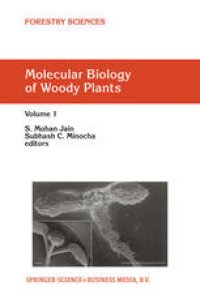
Ebook: Molecular Biology of Woody Plants: Volume 1
- Tags: Tree Biology, Plant Sciences
- Series: Forestry Sciences 64
- Year: 2000
- Publisher: Springer Netherlands
- Edition: 1
- Language: English
- pdf
Woody plants constitute an artificial and heterogeneous group of plants that share some common phenotypic characteristics but otherwise have no strong evolutionary relationships, nor do they share a common habitat. They are a primary source of fiber and timber, and also include many edible fruit species. Their unique phenotypic behavior includes a perennial habit associated with extensive secondary growth. Additional characteristics of woody plants include: developmental juvenility and maturity with respect to growth habit, flowering time, and morphogenetic response in tissue cultures; environmental control of bud dormancy and flowering cycles; variable tolerance to abiotic stresses, wounding and pathogens; and long distance transport of water and nutrients. Woody plants, particularly tree species, have been the focus of numerous physiological studies to understand their specialized functions, however, only recently have they become the target of molecular studies. Recent advances in our understanding of signal transduction pathways for environmental responses in herbaceous plants, including the identification and cloning of genes for proteins involved in signal transduction, should provide useful leads to undertake parallel studies with woody plants. Molecular mapping techniques, coupled with the availability of cloned genes from herbaceous plants, should provide shortcuts to cloning relevant genes from woody plants. The unique phenotypes of these plants can then be targeted for improvement through genetic engineering. In this book we present a broad coverage of various aspects of plant molecular biology that are relevant to the improvement of woody plant.
This book gives a broad coverage of various aspects of plant molecular biology that are relevant to the improvement of woody plants, and is divided into two volumes. In Volume 1, background information on genetic engineering and molecular marker techniques is emphasized, whereas Volume 2 contains specific examples of species in which sufficient progress has been made to date. The first few chapters in Section 1 of Volume 1 focus on the current status of transgenic expression in plants and molecular aspects of development in woody plants, while the latter half of this section includes chapters on molecular biology of cell wall biosynthesis and nitrogen metabolism. Section 2 of Volume 1 covers tissue culture of woody plants and its relevance to molecular biology research, and the role of molecular markers in evolution, genome mapping, and aiding in breeding programs for the selection of desired genotypes. Volume 2 covers general aspects of the technology of gene transfer in woody plants and several examples of the current status of the applications of the techniques of molecular biology to woody species.
This book gives a broad coverage of various aspects of plant molecular biology that are relevant to the improvement of woody plants, and is divided into two volumes. In Volume 1, background information on genetic engineering and molecular marker techniques is emphasized, whereas Volume 2 contains specific examples of species in which sufficient progress has been made to date. The first few chapters in Section 1 of Volume 1 focus on the current status of transgenic expression in plants and molecular aspects of development in woody plants, while the latter half of this section includes chapters on molecular biology of cell wall biosynthesis and nitrogen metabolism. Section 2 of Volume 1 covers tissue culture of woody plants and its relevance to molecular biology research, and the role of molecular markers in evolution, genome mapping, and aiding in breeding programs for the selection of desired genotypes. Volume 2 covers general aspects of the technology of gene transfer in woody plants and several examples of the current status of the applications of the techniques of molecular biology to woody species.
Content:
Front Matter....Pages i-ix
Optimization of the expression of a transgene in plants....Pages 1-30
Genetic Engineering in Forest Trees: State of the Art and Future Perspectives....Pages 31-49
Molecular biology of somatic embryogenesis in conifers....Pages 51-87
Molecular Aspects of Bud Dormancy in Trees....Pages 89-134
Options for Genetic Engineering of Floral Sterility in Forest Trees....Pages 135-153
Molecular Control of the Development and Function of the Vascular Cambium....Pages 155-180
Genetic Engineering of Wood Formation....Pages 181-203
Molecular Biology of Cellulose Biosynthesis....Pages 205-225
Control of Lignin Biosynthesis....Pages 227-267
Molecular Biology of Tropical Nitrogen-Fixing Trees in the Casuarinaceae Family....Pages 269-285
Proteins of the Conifer Extracellular Matrix....Pages 287-297
Gene Expression during Pseudotsuga Menziesii Embryogenesis: Low Molecular Weight Proteins....Pages 299-314
Tissue Culture of Woody Plants and Its Relevance to Molecular Biology....Pages 315-339
Variation in Woody Plants; Molecular Markers, Evolutionary Processes and Conservation Biology....Pages 341-373
Molecular Markers and Genome Mapping in Woody Plants....Pages 375-394
Assessment of Biodiversity with Molecular Tools in Forest Trees....Pages 395-406
Mapping Quantitative Traits in Forest Trees....Pages 407-423
Somaclonal Variation and Genetic Molecular Markers in Woody Plants....Pages 425-449
Back Matter....Pages 451-474
Population Genetic Analysis of Pathogenic Forest Fungi....Pages 475-490
....Pages 521-524